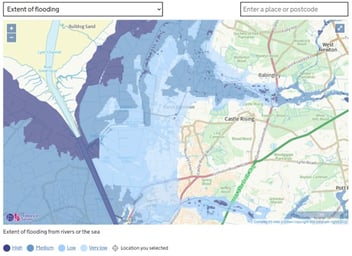An introduction to Weather Risk
Allocation of risk in construction contracts is fundamental to the success of the project. In the best-case scenario, all risks are identified and quantified so all parties are clear about the agreement they are signing.
Unfortunately, we live in a world where there is subjectivity and implicit risk being assigned in all contracts, even in those that strive to be more objective like the NEC.
Specifically, when thinking about weather, it’s important that both parties truly understand the implications of what is being written into the contract and the acceptance of risk that is being made.
For example, if the employer is assigning all the weather risk to the contractor, then it's important they understand the cost and time implication of this action.
It’s damaging to the contractor and the success of the project to expect the contractor to take large amounts of risk and to not have a sufficient buffer of time and cost to account for even the most extreme weather, given the allocation to manage all the weather risk.
Equally important is for the contractor to understand the full extent of the risk they are taking. Otherwise, how are they to plan for the worst-case scenario to keep the project timeline on track and to make a margin?
Today, things are left up to gut-feel and chance. With weather being a constant excuse, an often-quoted reason for compensation events, disputes, as well as lost time and profit.
In this article I want to peek into the world of contracts and examine some of the uncertainty they create. I want to show you that weather and commercial risk is being loaded into projects through standard weather clauses and to highlight the inefficiency these standard clauses can bring.
3 Types of Construction Contract
Standard forms of contract save a huge amount of time compared to bespoke contracts.
They also offer greater protection due to case law that can be referenced about them, and they are in most cases regularly updated with improvements. Of course, within these contracts there are favourable clauses and those where either party may have to accept trade-offs.
Given they have been developed in tandem with the industry they will generally align with your project, but they may not be the best fit for the work being carried out. This is particularly true of the weather clause where location, project type and project duration play a significant role in the amount of weather exposure that is being taken on.
In this article I’ll focus on three of the most commonly used standard forms of contract:
- NEC: New Engineering Contract
- JCT: The Joint Contracts Tribunal
- FIDIC: The International Federation of Consulting Engineers
How weather is dealt with in these clauses
The NEC aims to have an objective weather clause with clear thresholds where the employer becomes responsible for the risk. It also offers both time and money in the instance a compensation event occurs. With the NEC the weather event must be measured with data and should be recorded:
- within a calendar month of the compensation event
- before the Completion Date for the whole of the works
- at the place stated in the Contract Data
This information should then be compared with historical data from the local station. If the data shows that the event happens on average less than once in every 10 years, then this constitutes a compensation event. Within a month the following measurements are in the contract as standard:
- cumulative rainfall
- the number of days with rainfall of more than 5mm
- the number of days with a minimum air temperature of less than 0 degrees Celsius
- the number of days with snow lying on the ground at a set time

JCT and FIDIC both take a broader, more subjective approach. The JCT has a simple statement, that “exceptionally adverse weather conditions” are relevant events under the contract.
This lack of detail makes it difficult to prove events that are in the grey area. The contractor is required to inform the employer how this weather has delayed them and make a claim for an extension of time, but ultimately the outcome of this will be down to the employer's interpretation and the financial risk is borne by the contractor.
FIDIC includes slightly more information, “exceptionally adverse climate conditions, which for the purpose of these Conditions shall mean adverse climatic conditions at the Site which are Unforeseeable having regard to climatic data made by the Employer…and/or climatic data published in the Country for the geographical location of the Site.” This does help provide a steer as to how proof will be provided but it still makes no assessment as to what constitutes adverse weather.
In all three of these instances there are varying degrees of risk that are being loaded into the contract. It still remains to be seen if all parties involved fully understand the extent of the risks they are taking when it comes to weather.
The risks associated with these types of wordings
Contracts and their risk sharing mechanisms are in place to provide a fair and equitable provision of risk. In all three cases the weather clause offers an unbalanced approach, which is fair to neither party.
There are risks associated with planning and proving the event or its impacts, the uncertainty of which could easily be greater than the value of the time or money that may be claimed back in the first place.
It's unfair to both parties because they are both being asked to make judgement calls that they are inherently biased to argue in their own favour, creating a friction point in what is supposed to be a mechanism for equitable risk distribution.
Problems with planning
When planning a project under any of the previously mentioned standard contracting types, how should you go about understanding how much weather risk you are taking on?
In the NEC you need to understand what the 1-in-10 year thresholds are and how these could influence any of the thousands of activities you will be doing on site. This is a serious challenge as most construction companies will at best have a pdf report from the Met office and at worst, nothing.
Placing this data into the context of a project and understanding the implications of events in and around that threshold will enable a fair assessment of risk to be made and adequate plans to be put in place to mitigate those risks. Not an easy task with current tools.
Another quirk of planning under the NEC is that you have to assess your weather risk per calendar month, except weather doesn’t care about such arbitrary boundaries.
For example if an event is split by the boundary of a month, a rain storm happening over the tail end of January and beginning of February, what do you do? It’s unlikely that would count as a compensation event, even if a historic amount of rain had fallen during the course of the event, as the monthly budget may well have cut in half the recorded rainfall.
It is impossible to determine the likelihood of this event happening in this particular way with the data available to you from the Met office. If you can’t determine the likelihood of this happening, then how can you adequately price for the uncertainty of not being able to claim back your time and cost from this type of event?
Let alone how could you prove to your employer that this was a sufficient risk to include in the contract?
Similarly with JCT and FIDIC. Given that there is actually no threshold, planning becomes tricky here too. When you start to put your activities into the plan are you factoring in your definition of exceptionally adverse?
What if this is different to what the employer's definition would be? Risk is being added here that no one can quantify.
If no one can be sure of this, then what is the chance that an event happens and this turns into a dispute that costs time and money with absolutely no added value, or even has implications on the rest of the project?
You might argue they are slim, but given the changing climatic conditions we are faced with today these events are becoming more common and the damage they cause is increasing, which clearly raises the stakes surrounding this clause.
Without clear boundaries around adverse weather to use in the planning process projects are left with no other choice but to go into the project blind.
The proof is in the data
The next big risk within these clauses are the rules, or lack of rules, by which an assessment should be made. In all three cases it is expected or stated that data should be used to prove this, but the key unspoken issue is what to show with the data once you have it.
In the NEC for example, you must show how the difference between the 1-in-10 year threshold and the event in question has caused the delay. It would likely be determined in a similar way in JCT and FIDIC too.
How can you prove that 5 more millimetres of rain than the threshold has caused significant delays on your project? If all the weather below the threshold is your risk as a contractor, then that should be something you have already foreseen and accounted for. It’s only the remaining rainfall that would be factored in.
What if the site is already flooded? How would 5mm more of rain have any bearing on the implication of the flood? To get valid proof you would need to model the delay and cost implications of a severe event vs an exceptionally adverse event, otherwise how are you to know what the effect of a less severe event would be?
No contractor has the ability to do this today.
Within the NEC this could be even more pronounced given the calendar based measurements. If there was an extremely rainy day which flooded the site, possibly helped by a previously wetter month saturating the ground, or a hot month baking the ground, and that day did not go over the threshold for a 1-in-10 year event that month, then that whole event would be considered contractor risk.
Unfortunately that one severe day could have been a 1 in 20 year event, but it did not fit the parameters offered by the NEC. That would be fine, if the contractor had planned and modelled the risk on this basis, but today they have no ability to do so.

Wiggle room, an unquantifiable risk
Leaving such large amounts of wiggle room in all of these clauses, especially with weather, which is an ever changing risk, is a key driver of contractual and financial risks.
The rapidly growing risk of the climate crisis is being exacerbated by the industry's old fashioned contractual approach.
The NEC reduces wiggle room by defining the thresholds but increases it with the recording of data by calendar month, by allowing a station miles away to be the determining dataset and by providing no set methodology by which to assess the claim.
The JCT increases wiggle room through a lack of detail of what adverse means, and leaves the entire clause open to interpretation from either party.
FIDIC similarly to JCT lacks detail on the interpretation and although it states that data should be used at the site location, this does little to close possible loopholes as with the NEC there is no set methodology for the assessor to follow.
What does the future look like?
Identifying and quantifying risk is essential for the appropriate management of that risk. Weather risk is no different. Too often the weather clause creates extra friction in the allocation of risk and fails to allocate the risk fairly, therefore a different solution should be proposed.
At EHAB we have developed the first smart contract use case for construction which we believe can solve the uncertainty baked into the weather clause.
It requires upfront agreement and cooperation from the contracting parties and requires the use of data to determine the allocation of risk as well as the arbitration of the impact.
All things that should and can result in a better risk sharing agreement that builds resilience from the outset and reduces, possibly even removing, contractual and commercial risk from the weather clause. We will write more about our smart clause, how it works and how it can be administered in another article.
The fundamental basis of this smart clause is that it’s automatic. There is no need for assessment. Parties have agreed to a set of criteria, which has been illustrated by data to be a fair assessment of the risk sharing agreement based on the project at hand, and the contract is self-executing. It is bespoke, and standard simultaneously.
If this has piqued your interest then my call to action is this:
If you want to help shape and discover the path forward for the industry when it comes to contracting, then please get in touch.
We are looking for a forward thinking client and their contractor(s) to adopt the next iteration of our tool. For more info check out our page on Smart Contracts in the Construction Industry and if you subscribe to our newsletter then you will be the first to read my article diving deeper into how our technology addresses some of the points raised here.




